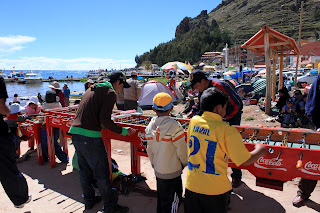Easter celebrations have been in full force for the past week in Bolivia. Even though it feels like we’re in a country so different from ours, these have been familiar reminders that cultures are not all that different.
We arrived into Copacabana on Good Friday, just as all of the La Paz pilgrims were making it into town. Not only was this a religious weekend, but it was also a big festival for the Bolivians. There were lots of children’s games like coin toss, kick the soccer ball into the cans, and foosball. If you’re from Middletown, Ohio, think All-American Weekend.
The number of people completely overwhelmed this tiny town and most of the locals spent the night sleeping in tents on the beach.
Copacabana’s church was unlike anything we’d seen so far in South America because it’s a sprawling white complex that is completely disproportional to the rest of the town.
The one common element of all South American churches is the virgin statues displayed around the sanctuaries. In Copacabana they have two in particular that are very special. The first is Virgen de Candelaria, who is considered extremely unique in that she’s dressed in all black. The second is Virgen de Copacabana. Given that we’re in Copacabana, she’s kind of a big deal. The entire weekend there was consistently a line through the middle of the church waiting to visit with her.
The most famous part of Copacabana’s Easter celebration is the candle-light procession on Good Friday that begins in the church after sunset. After a long and monotonous reading that seemed to never end, the Virgen de Candelaria made her appearance down the aisle surrounded by candles.
Then all of the priests gathered around the large cross at the altar and began to unhook the body of the Jesus statue. The murmurs of the crowd silenced as his arms swung down from the cross. It was amazing how life-like he looked, and when I glanced back at the pews behind me, everyone’s jaws were dropped in awe. The priests placed the body inside a glass case and it was escorted out of the church by people in purple and white hooded robes.
Through the streets of Copacabana, a large candlelit cross, the Virgen de Candelaria, and Jesus in the glass case were paraded with throngs of followers in a candlelight procession.
On Easter Sunday, there were 7 services throughout the day. The service that we went to was 90 minutes long (it ran 30 minutes over schedule), and of course was all in Spanish. We enjoyed trying to follow along with the bulletin. Because the acoustics of the big church gave off a lot of echoes, half of the service was scripted to what was in the bulletin. The other half was completely rogue and we had no clue what was going on. The highlights were when the priests walked down the center aisle flicking holy water into each pew with long roses, and when all of the children went up to the front of the church and the priests handed them lit candles while everyone sang. It was a beautiful moment, but on second thought, extremely dangerous.
People don’t get dressed up to go to church here…it’s all very casual. In fact I would say that there was quite a bit of commotion during the entire service. There were lots of people talking, trickling in or waiting in line to see the Virgen de Copacabana, cell phone usage, standing down the outside and center aisles, and we even saw two stray dogs roaming around during communion. Even though their services maybe aren’t as quiet as what we were used to, they’re holy nonetheless. These are very religious people who feel a strong connection to the church and its many symbols. They bring gifts of flowers or crosses made out of palms. We saw a few lilies, but the Easter flower of choice is the gladiola…mostly coral in color, but also white and purple.
By far, our favorite ritual was the Blessing of the Vehicles. This happens every Sunday at the church in Copacabana, but is particularly extravagant on Easter. Early Easter morning, cars line up on the street that leads up to the church. The line is so long that many of the cars are abandoned until there is movement. People completely trick-out their cars with colorful decorations like elaborate flower arrangements, flower petals and plastic top hats that resemble those worn on New Year’s Eve.
When a car reaches the top of the hill at the church, a friar meets the family and begins the ritual. Normally the family hands the father a piece of paper…perhaps with a prayer on it? They open up the hood of the engine and the father walks around flicking holy water inside and outside of the car.
Then they get in a circle to say a prayer and he sprinkles each family member with holy water.
After the prayer, the family goes around throwing rice, flower petals, more holy water, and champagne all over the car. Then they set off firecrackers on the street in front of the vehicle and that signals that the ritual is over. While we were in church service, we could hear the firecracker pops from outside the sanctuary.
This was one of my favorite cultural highlights of our trip so far. Happy Easter from Copacabana!
















No comments:
Post a Comment